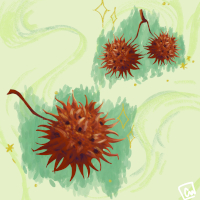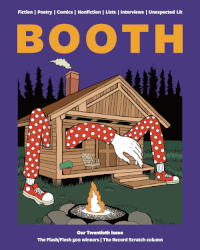by Taneum Bambrick
2018 Nonfiction Prize Winner
The waiting room of the Public Utility District’s office was a trophy case. Framed articles documenting the positive effects of the dams hung neatly around a massive fish tank—images, for example, of the reservoir fostering summer communities; of a family at a barbeque, grilling salmon meat. Other photos insisted on the district’s commitment to environmental awareness and advocacy. There was one of my maintenance crew as we strung a wire fence around the base of the single tree that harbored a bald eagle family. When you entered the office, the fish were the first thing you saw. Their movement reminded me of wind-up toys as they bobbed from the pebbles to the surface or floated dumbly in place. Passing time between meetings, I would cool my hands on the glass. Once, the woman at the front desk asked me if I knew why the water was kept just above freezing. When I said I did not, she explained that it stunts fish growth indefinitely. So they can stay longer in the tank. I turned to watch them. Shark figurines, following my finger with crazed, stamped-in eyes.
…
The gold nameplate on the tank read: White Sturgeon, Our Fossil Fish. Ours because they live in the river, and we control its movement. Sturgeon haven’t evolved in more than seventy million years. Instead of scales, their sides notch with triangular bone plates called scutes, as if our spines sat on the outside of our skin. The largest single sturgeon on record grew to twenty feet long and over a thousand pounds. Some live to one hundred years old. This means that some sturgeon alive today experienced the building of the reservoirs. They swam the river before it stopped and were once anadromous, or accustomed to migrating between freshwater and ocean before their route was landlocked.
…
The dams shut off the majority of sturgeon reproduction. In stagnant water, their loose eggs coat with sand. Even if they could reproduce, it’s rare they find a mate. Sturgeon thunder is the term used for their attempts to call out to one another with the small noises they make by slapping themselves with their tail fins. Imagine that sound competing against clustered party barges and racing jet skis on the surface of those reservoirs, which, in some places, reach an unnatural depth of 120 feet. As a child I swam to the bottom of swimming pools. Opening my mouth to let out air, I’d imagine myself as one of the leaves dragged to the deep. I remember listening to my mother above, how her calm voice changed shape, somehow registered as a scream.
…
As an employee of the PUD, I met sturgeon fishermen who made it to the windy hill below the dam every Saturday at six in the morning, where we worked picking up trash. They were rough, unshaven, and disinterested as the crew and I walked past. Once, I watched as a man laid his body on a flapping, whale-like fish until it steadied so his partner could shoot it. For these people, catching a sturgeon was as significant a win as bagging an elk with a full rack. It was like buying a whole cow: a freezer full of meat. Reeling one in could take hours. People who do so off-shore have to anchor their poles in flat river rock to keep themselves from falling. Our crew became friends with one fisherman in particular, named Red, who described sturgeon fishing as a matter of mental endurance and respect.
…
As kids swimming in the reservoir during the summer, my friends and I felt unsettled picturing these gargantuan creatures knifing through the water below our bare feet. We’d pinch each other. Make noises like swallowing. One morning while we emptied cans at the river, Red told our crew that when he’d had to take a month off from fishing to get brain surgery, the scariest thing was not knowing how long it would be before he could see the silver of a sturgeon on his line, dragging under the surface. In the hospital that image in his head worked as a kind of beckoning.
…
My father and I fought throughout my childhood with the persistent aggression that exists only between two people who refuse to surrender the shape of their memories. At different points in our lives, we both worked for these dams: me gathering trash around them, and him researching ways to improve fish passage. He currently serves as a fish biologist in Eastern Washington. He informs me that sport fishermen are some of the only advocates for funding white sturgeon restoration. It’s an ugly fish, he says. It’s difficult to elicit empathy for them.
…
Fish ladders were engineered to pass salmonids. Sturgeon are often trapped in turbine shafts, looking for a way through. While working for the dam, my father rescued sturgeon by lifting them up from the chambers on hospital stretchers, carrying them through the narrow hallways and stairwells of the dam, and dumping them back into the reservoir. I like imagining him, at my age, executing this process: inventing a layered solution that suggested what was simple and human in every crisis.
…
Because they hover near the dark, spongy base of the river, sucking on clams and other crustaceans, sturgeon are easy to forget. Maybe they seem healthy because they’re enormous. North American white sturgeon are an endangered species. Recently, the district was forced to act on behalf of the sturgeon through its Federal License Requirement, a process it endures every ten years to demonstrate its attempts to mitigate the environmental degradation caused by the dams. The license asked for an initiative to increase the sturgeon population. This was something I could discuss with my dad. Over the phone, around a subject, my admiration for him was as acute and undisturbed as it got. He told me that the company responded to the government’s demands without actually improving the sturgeon habitat. Instead, it created a six by six spawning matrix in tanks, and after generating 6,200 offspring the company invited locals down to the river for the release. I found a newspaper clipping of a human chain, passing the first, symbolic bucket of juvenile sturgeon to dump into the hot reservoir.
…
There is a wheel in my father’s office desk that broke off the bottom of a couch in our living room when he attempted to throw it. I remember it, but my sister doesn’t. I covered her face with my hands. When I visit him at work to discuss my research about the dam, I talk to him across this surface. I know that the wheel is somewhere in the desk drawer above his feet. I know because he showed it to me and said that he takes it out often and decides, every time, to put it back. Some of this I understand.
…
On a road trip three years ago, my ex-girlfriend and I stopped the car so we could finish a fight. There we found a visitors’ center with a sturgeon viewing tank inside. To get to it, we walked through a line of concrete hatchery ponds, where thousands of trout smolt shimmered like folds of tinfoil in the sunlight. The viewing room was a concrete tube that looked into a pond of adult sturgeon. The fish lifelessly circled the small space. Like the worn plastic horses of a carousel, they had a course and a set pace. My girlfriend and I stood there silently, while family after family asked us if we wanted our pictures taken with the fish, their gray bodies sliding against the glass of the tank. Claustrophobic, we forgot our fight. Instead, we thought about the kind of violence that commodifies its own impact, makes a little zoo for what it forces out of life.
…
Before he was upset so easily, how was he? I wonder as my father snaps at my mother in the passenger seat. I credit so much to my own inaction, to our collective inability to speak. When my sister and I were younger, we’d go with our mother to our father’s office at Fish and Wildlife, where he often housed live animals that, before they were relocated, had threatened park sites. Our favorite animal was a juvenile brown bear that sat in a chain-link cage by our father’s desk, growling, sweating a foresty stink. When big-horned sheep couldn’t cross the freeway, my father hung nets from a helicopter and lifted them to safety. He is largely credited for the designation of the Hanford Reach, a wildlife preserve that protects the land poisoned by the plutonium involved in the creation of the nuclear bomb. I remember when he was flown to Washington, DC, to receive an award for his work protecting that habitat. People started calling him strong, saying he was good at pushing a message. After a government agency recruited him, he was installed in a tiny office above a RadioShack. He looks enormous behind a desk, his hands like baseball mitts writing documents, approving funding. He’d never cared about having political influence. He missed seeing change take physical shape, bringing my sister and me to places where beavers caused pools to return to otherwise drying streams.
…
When I was fourteen I met a boy who was leaving our small town to attend a Seattle university. My parents fought over how to contain our relationship. This was when my father switched. His gentleness coated in a kind of anger that seemed constant. Everything I did was in spite of him. I skipped school to meet the college boy halfway across the state. We slept in the woods in the back seats of cars in abandoned buildings in the grass beside an old winery. I felt too young to have sex so I refused his repeated advances. To me our relationship was no more than a way to redefine power; in it I thought I could find a fragment of agency.
…
In a borrowed sedan he said: Don’t worry, this will be the fastest thing. Every girl I’ve been with. Stay where you are. You could be asleep. He held my head. You have no idea how beautiful you’ll be. What you’re about to mean.
I was shown my own nothing. Rocks cracking off the lip of a canal dam. The punch of freeway signs in car light. My own hair detached, dented like a nest in the palm of my hand.
…
After, hospital visits. A paper bag at my mouth. Butterfly stitches. My father carried me in. I thought I’d developed asthma or the inability to sit in tight spaces. He and my mother held what happened to me between them as a kind of evidence. What was broken? They said everything they shouldn’t have: how I got myself into that situation. My father later wondered if I couldn’t be with men because of him. Maybe, he imagined, you’re dating women because I was bad. All I had to do was keep you from exactly what happened.
…
When I tell people about my experience working on the maintenance crew around the dam, a question some ask is, Why would you stay? The question tells me so much about the person who asks it. Of course, I had no money, and this was as well off as I’d ever been, making overtime pulling goat heads out of trails, painting graffitied rocks gray again. But also it was the challenge. I was the only person asked in our interviews to show that I could lift fifty pounds above my head. Every day, dumping garbage, I carried more weight. To prove I could, I ate ten hot dogs during one lunch break. For the first time in years I felt like I operated my body. At the end of the day my parents would wait to hear my stories. They were horrified by how I carried the stench of trash, the dead animals we saw, the sexism, but they were proud of how I handled that group of men. My father and I became closer because we were some of the only people in the world thinking about the well-being of Columbia River sturgeon. How they carry history. I don’t know that I would have found him again otherwise, over the weight, over the quiet, over the inability to forgive ourselves for interfering.
…
When we build a dam we stop flow, creating shelves of inhospitable clay. The water experiences steep temperature change. We lose insects, the red or black streaks of healthy eggs. To restore sturgeon populations people have brought in gravel. Regraded banks. Shoveled out pools where fish can rest their overheated bodies on their way to a safer space. Even in our best attempts at reparation we excavate, make the river like we’d shape a driveway.
…
There were spiders on the water that night I had to decide what I could live with. Mosquitos in the orange damlight, drumming. I wanted to stay afraid, hold to that swollenness like a moss on my neck. How could we drill down those walls of concrete? Towers drawing power from boxes. The houses the houses the houses at the edge of the made beach. We can only save the river with our memory of what the river means.



